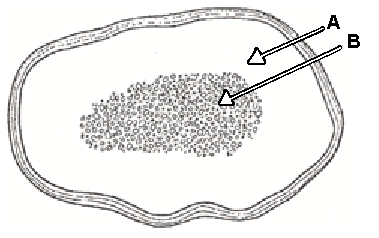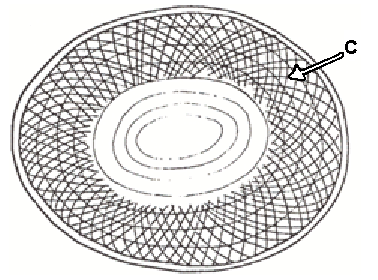Care of Ivory, Bone, Horn and Antler – Canadian Conservation Institute (CCI) Notes 6/1
Introduction
Many museums have objects that are made from ivory, bone, horn, or antler. Proper identification of these materials is important, as it may determine the type of care required for the object's continued well-being.
Identification
Ivory and bone
Ivory and bone are very similar in chemical make-up, but their physical structure is quite different. Both consist primarily of inorganic materials (which provide strength and rigidity), and both have an organic component to provide the capacity for growth and repair. The main structural difference between the two is that ivory has no marrow or blood vessel system. It is essentially tooth material. It is usually whiter, harder, denser, and heavier than bone. Bone, on the other hand, has a spongy central portion of marrow from which a series of tiny blood vessels extends into the more solid areas. These vessels appear as tiny dark spots, pits, or lines on the surface of bone objects. There is generally a larger proportion of spongy material in the bones of sea mammals (extensively used by coastal peoples) than in the bones of land mammals.
Walrus and elephant ivory
Many animals (e.g. the hippopotamus, warthog, and narwhal and sperm whales) produce tusks and teeth that have been used for carving in Canada, but walrus and elephant ivory are the two most common types found in collections. Walrus ivory is characterized in cross section by a central core that has a marbled appearance, surrounded by a smooth creamy white dentine layer (Figure 1a). Almost all Inuit ivory carving is walrus ivory. Elephant ivory is characterized in cross section by a series of intersecting lines (Figure 1b) that are whiter and more opaque than the surrounding material. These lines are frequently noticeable on the underside of carvings of elephant ivory, where it has been cut across the tusk.


Antler
Antler is a modified form of bone that grows out of the skull bones of certain species of animals. It has a thick outer layer of compact bone, an inner section of spongy bone, and internal blood vessels that are less numerous and more irregular than in bone. Antler is denser and heavier than bone, and the outer surface often has a dark, rough texture.
Horn
Horn consists of the same material as hair, hooves, and fingernails. If examined closely, it resembles a mass of very hard, hair-like filaments cemented together. Horn grows around a spongy core. If the core is removed from the horn, a hollow object, such as a powder horn, can be made. Horn can also be boiled, cut, and moulded to other shapes, or used in flat sheets.
French Ivory
French Ivory is a synthetic material usually composed of pigmented cellulose nitrate and/or casein (CCI Notes 15/3 Display and Storage of Museum Objects Containing Cellulose Nitrate). It was commonly manufactured in the late 19th and early 20th centuries, and looks very similar to elephant ivory. It can even exhibit the intersecting line pattern, although the manufactured pattern is more regular than the pattern found in natural ivory. Occasionally it is marked as synthetic. "French Ivory" and "India Ivory" are two of the more common markings. It is not as heavy as real ivory and its overall coloration is more even. Cellulose nitrate objects can be identified using a chemical spot test with diphenylamine (CCI Notes 17/2 The Diphenylamine Spot Test for Cellulose Nitrate in Museum Objects). For more information, contact the Canadian Conservation Institute.
Cellulose nitrate can degrade to produce acidic and oxidizing nitrogen oxide gases. In thin films, degraded cellulose nitrate has been known to undergo spontaneous combustion. Therefore, any cellulose nitrate objects showing signs of deterioration should be isolated from the rest of the collection (for more information, see CCI Notes 15/3 Display and Storage of Museum Objects Containing Cellulose Nitrate).
Care
Handling
Artifacts of ivory, bone, horn, or antler should be well protected from sudden changes in temperature and relative humidity (RH) whenever they are removed from the museum. This can be done by wrapping them in unbuffered, acid-free (neutral pH) tissue paper and placing them in a sealed polyethylene bag for transportation.
Be careful when handling or cleaning these artifacts, especially porous bone objects such as Inuit whalebone sculptures, which are very fragile.
Storage
Store artifacts in a tightly closed display case or storage drawer to buffer them against sudden changes in temperature and RH, and shield them from dust and dirt. Storage in the dark will also protect light-sensitive dyed or painted surfaces.
Bone, ivory, and antler are rarely attacked by insects, but horn is often seriously damaged by the larvae of carpet beetles and clothes moths. Inspect objects at least twice a year for insects and mould growth (CCI Notes 3/1 Preventing Infestations: Control Strategies and Detection Methods) and 3/2 Detecting Infestations: Facility Inspection Procedure and Checklist). Immediate attention is required if an infestation is detected. Contact the Canadian Conservation Institute for advice.
To guard against bumping and chipping, line storage drawers and shelves with a chemically stable cushioning material such as polyethylene or polypropylene sheeting (e.g. Ethafoam or Microfoam).
Avoid using rubber-based materials for storage or packing as these can produce unnatural yellowing of ivory.
Cleaning
Ivory, bone, horn, and antler are all porous materials susceptible to staining if left in contact with corroded metals (such as copper or iron) or coloured materials. Stains of this nature should be referred to an experienced conservator for treatment. However, if the objects are in good physical condition, normal surface dirt and grime can be removed safely. A light dusting with a soft brush is often all that is necessary to keep objects clean. Use the brush to dislodge dust and debris, directing it toward a gauze-covered vacuum cleaner nozzle.
If dusting alone is not enough, ivory and smooth non-porous bone can be cleaned with water and mild soap such as Ivory Snow or WA Paste (CCI Notes 13/9 Anionic Detergent). Using a cotton swab (Q-tip), apply the soapy solution sparingly, just dampening the surface. Clean only a few square centimetres at any one time. The surface should remain damp for only a few seconds, and then be dried immediately with a cotton swab or soft tissue. Clean the area a second time in the same manner using only water to remove any soap film. Avoid applying water to cracked or porous surfaces and, above all, never soak a piece of bone or ivory.
Ivory and bone may develop an attractive brownish yellow "patina" over the years. This is the result of a natural aging process and, as there is rarely any aesthetic reason for trying to whiten the artifact, no attempt should be made to remove this patina.
Many types of Oriental ivories have a patina that was deliberately produced by special surface staining. These objects are vulnerable to careless handling or cleaning. Processes such as sanding or bleaching will almost certainly cause serious damage.
Horn is somewhat more durable than bone and ivory, and the above cleaning methods can be applied to it as well, providing the surface is intact and not delaminating. However, horn in the form of thin films (as in lanterns) can be softened very quickly by contact with water and may well be deformed; do not use water on these artifacts.
Illumination
Do not place ivory, bone, horn, and antler in bright areas, such as direct sunlight or near spotlights. Illumination should be kept below 150 lux, with the ultraviolet (UV) component restricted to 75 µW/lm. Objects that are coloured with dyes are extremely light-sensitive and should be exposed to no more than 50 lux. Limiting exhibition time will help reduce light damage, which is cumulative and irreversible. More in-depth information on light is available in Light, Ultraviolet and Infrared. For information on measuring light levels and filtering UV radiation, refer to CCI Notes 2/4 Environmental Monitoring Kit (retired) and 2/1 Ultraviolet Filters, respectively.
Be careful when using tightly sealed display cases. The radiant heat from light sources can quickly produce very high temperatures and rapid fluctuations in RH within the case, which can damage sensitive materials. A bright light beam directed at an artifact can also raise its surface temperature. To reduce the risk of damage, maintain low light levels and use lights that emit less radiant heat.
RH and temperature
Of ivory, bone, horn, and antler, ivory is the most sensitive to changes in RH and horn is the least sensitive. Ivory is a hygroscopic material, like wood. It absorbs or releases moisture with changing humidity, swelling or shrinking in response to variations in its moisture content. Cyclical changes in RH can cause very severe cracking and warping. This problem is particularly acute with thin ivory objects, such as portrait miniatures.
Ideally, ivory, bone, horn, and antler should be displayed and stored at a temperature not greater than 25 °C and an RH in the range 45–55 %. In practice, these conditions are often difficult to achieve in many Canadian museums, especially in winter. However, try to maintain as steady an RH and temperature as possible, and, most important, prevent exposure to extreme conditions or rapid fluctuations. Always keep objects away from direct sunlight, hot light sources, ventilation or heating ducts, fireplaces, the top of appliances (such as radios or television sets), exterior walls, or cold windows. Climate Guidelines describes CCI’s current approach to controlling RH and temperature in heritage institutions and provides tools to help institutions make decisions. More information regarding RH and temperature is available in Incorrect Relative Humidity and Incorrect Temperature.
A special caution applies to French Ivory. Because it is usually composed of cellulose nitrate, it is potentially flammable and must be kept away from heat or other sources of ignition.
Repair
Broken, friable, or extremely dirty objects requiring repair, consolidation, or extensive cleaning should be referred to an experienced conservator. Contact the Canadian Conservation Institute for advice.
Suppliers
Note: The following information is provided only to assist the reader. Inclusion of a company name in this list does not in any way imply endorsement by the Canadian Conservation Institute.
Cotton swabs (Q-tips), mild detergent (Ivory Snow):
- drug or grocery stores
Unbuffered, acid-free (neutral pH) tissue paper:
- conservation product suppliers such as:
Microfoam:
WA Paste:
- contact Canada Packers sales offices in Vancouver, Edmonton, Winnipeg, Toronto, or Montreal (which serves Quebec and the Atlantic Provinces)
Bibliography
-
Lafontaine, R.H., and P.A. Wood. "The Stabilization of Ivory Against Relative Humidity Fluctuations." Studies in Conservation 27, 3 (), pp. 109–117.
-
Pedersen, M.C. Gem and Ornamental Materials of Organic Origin. Amsterdam: Elsevier, .
-
Penniman, T.K. Pictures of Ivory and Other Animal Teeth, Bone and Antler. With a brief commentary on their use in identification. University of Oxford Pitts River Museum Occasional Paper on Technology, Nº 5. Oxford, UK: Oxford University Press, .
-
Victoria and Albert Museum. The Care of Ivory. Technical Notes on the Care of Art Objects, Nº 6. London, UK: Victoria and Albert Museum, .
by Tom Stone
Originally published
Revised ,
Copies are also available in French.
Texte également publié en version française.
©Minister of Public Works and Government Services Canada,
Cat. Nº NM 95-57/6-1-2010E
ISSN 0714-6221